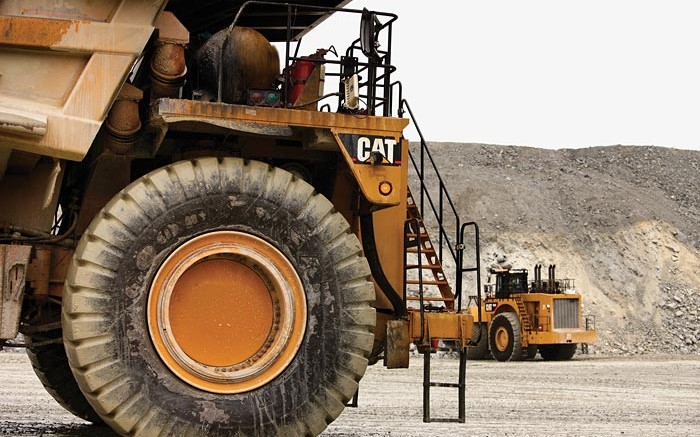Kinross Gold (TSX: K; NYSE: KGC) has put its US$1.6-billion Tasiast mill expansion project on hold to keep its balance sheet intact in the current low gold price environment, with at least one analyst thinking the firm is considering other mergers and acquisitions (M&A).
Raymond James analyst Phil Russo believes an M&A transaction could be in the cards for the company after its decision to defer the Tasiast expansion, previously the cornerstone asset in its long-term growth strategy.
Kinross bought the Tasiast mine in Mauritania along with the Chirano gold mine in Ghana in its controversial US$7.1-billion acquisition of Red Back Mining in 2010. It has since written down most of Tasiast’s value.
Last March, Kinross published a feasibility study for the Tasiast expansion that would replace the 8,000-tonne-per-day mill with a 38,000-tonne-per-day mill to produce 848,000 oz. gold a year during the first five years of production. (Last year, the mine produced 260,485 equivalent oz. gold.)
Paul Rollinson, who became Kinross’s CEO in 2012, says the firm believes in Tasiast’s potential but is mindful of the capital needed to finish the 35-month expansion.
“We intend to balance what is an attractive growth opportunity with the reality of the current gold price environment, and the project’s funding requirements over its three-year construction period,” Rollinson said on a recent conference call.
While Kinross has US$1 billion in cash, it would need to generate enough cash from its other operations to fund the rest of the construction, which could shrink the firm’s liquidity if the gold slump continues.
By delaying now, Kinross could revisit the expansion if market conditions improve, Rollinson said.
“It also allows us to preserve our financial flexibility to take advantage of other opportunities, should they arise,” he added.
Commenting on M&A opportunities, Rollinson said that “M&A is part of the fabric of mining,” and that Kinross is keeping its options open. “It certainly hasn’t been our principal focus, but we like everyone else have a view on what’s out there and what might make sense.”
A few options might fit the bill, Russo says, including “spinoffs from seniors in areas where Kinross is already operating,” near-term single asset producers or earlier-stage projects that could benefit from the company’s balance sheet.
Kinross could be among the potential buyers that signed an agreement on AngloGold Ashanti’s (NYSE: AU) Cripple Creek & Victor gold mine in Colorado.
Kinross operates three gold mines in the U.S., including Round Mountain in Nevada, Kettle River-Buckhorn in Washington and Fort Knox in Alaska.
Andrea Mandel-Campbell, Kinross’ director of corporate communications, declined to comment on Cripple Creek, but said the company continues “to keep an eye out for potential opportunities, as all mining companies do.”
The major has several internal growth opportunities and exploration targets near or within its mines, she adds, noting that Kinross is on track to complete a prefeasibility study on the possible restart of the La Coipa mine in Chile later this year.
Russo said the Tasiast expansion deferral, combined with his belief that “some form of M&A pursuit is likely to occur, offers upside to the current compressed multiples applied by the market on Kinross.”
However, BMO analyst David Haughton argues that Kinross’ decision to hold off on Tasiast shows it values balance-sheet strength over growth. The company hasn’t been an active shopper after its ill-fated Red Back acquisition, as it worked on restoring investor confidence and meeting its production targets. It has achieved its guidance for the last 10 quarters, Rollinson said.
In 2014, Kinross delivered record production of 2.7 million equivalent oz. gold, up from 2.6 million oz. in 2013, mostly due to higher production at the Kupol mine in Russia and the Maricunga mine in Chile. All-in sustaining costs fell 10% to US$973 per equivalent oz. gold sold in 2014, due to lower production cost of sales and reduced sustaining capital expenditures.
The net loss in 2014 was US$1.4 billion, down from US$3 billion in 2013. Last year’s loss included an after-tax impairment charge of US$932.2 million on property, plant and equipment, of which US$342.5 million was at Tasiast. It also took a separate inventory writedown of US$167.6 million, mostly at Tasiast.
Adjusted earnings were US$131.1 million, or US11¢ per share, which is slightly below the US13¢ per share that analysts had estimated. In 2013, adjusted earnings were US28¢ per share.
For 2015, Kinross is guiding production of 2.4 million to 2.6 million equivalent oz. gold, as it expects lower grades at three of its mines due to mining sequencing and lower output from the Tasiast dump leach.
All-in sustaining costs should come within US$1,000 and US$1,100 per equivalent oz. gold, slightly higher than 2014, as it projects lower production and a higher US$725-million capex.
Kinross shares closed Feb.12 flat at $3.73, after losing 7% a day earlier. The stock is up 14% since its 2014 close of $3.26.


Be the first to comment on "Kinross defers Tasiast mill expansion"